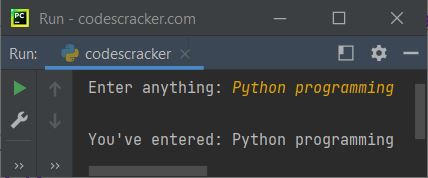- Python Built-in Functions
- Python All Built-in Functions
- Python print() Function
- Python input() Function
- Python int() Function
- Python float() Function
- Python len() Function
- Python range() Function
- Python str() Function
- Python ord() Function
- Python chr() Function
- Python ascii() Function
- Python pow() Function
- Python type() Function
- Python List Functions
- Python list() Function
- Python insert() Function
- Python append() Function
- Python extend() Function
- Python pop() Function
- Python remove() Function
- Python reverse() Function
- Python sort() Function
- Python sorted() Function
- Python Dictionary Functions
- Python dict() Function
- Python update() Function
- Python get() Function
- Python keys() Function
- Python setdefault() Function
- Python fromkeys() Function
- Python items() Function
- Python popitem() Function
- Python Tuple Function
- Python tuple() Function
- Python Set Functions
- Python set() Function
- Python frozenset() Function
- Python String Functions
- Python split() Function
- Python join() Function
- Python format() Function
- Python replace() Function
- Python Iterator Functions
- Python iter() Function
- Python min() Function
- Python max() Function
- Python sum() Function
- Python count() Function
- Python index() Function
- Python copy() Function
- Python clear() Function
- Python next() Function
- Python filter() Function
- Python enumerate() Function
- Python zip() Function
- Python reversed() Function
- Python Number Functions
- Python abs() Function
- Python bin() Function
- Python oct() Function
- Python hex() Function
- Python round() Function
- Python divmod() Function
- Python complex() Function
- Python File Handling Functions
- Python open() Function
- Python read() Function
- Python readable() Function
- Python readline() Function
- Python readlines() Function
- Python write() Function
- Python writable() Function
- Python writelines() Function
- Python close() Function
- Python seek() Function
- Python tell() Function
- Python flush() Function
- Python fileno() Function
- Python truncate() Function
- Python Class Functions
- Python object() Function
- Python property() Function
- Python getattr() Function
- Python setattr() Function
- Python hasattr() Function
- Python delattr() Function
- Python classmethod() Function
- Python staticmethod() Function
- Python issubclass() Function
- Python super() Function
- Python Misc Functions
- Python all() Function
- Python any() Function
- Python isatty() Function
- Python bool() Function
- Python callable() Function
- Python globals() Function
- Python locals() Function
- Python dir() Function
- Python id() Function
- Python isinstance() Function
- Python map() Function
- Python repr() Function
- Python slice() Function
- Python vars() Function
- Python Advance Functions
- Python help() Function
- Python hash() Function
- Python breakpoint() Function
- Python bytes() Function
- Python bytearray() Function
- Python memoryview() Function
- Python compile() Function
- Python eval() Function
- Python exec() Function
- Python Tutorial
- Python Tutorial
- Python Examples
- Python Examples
Python input() Function
The input() function in Python is used when we need to receive data from user at run-time of the program. For example:
print("Enter anything: ", end="") val = input() print("\nYou've entered:", val)
The snapshot given below shows the sample run of above program with user input Python programming

The above program can also be created in this way:
val = input("Enter anything: ") print("\nYou've entered:", val)
You'll still get the same output as of previous program.
Note: The input() function is one of the most used function in Python. As every time when we require user input in our Python application, the input() function comes into picture.
Python input() Function Syntax
The syntax of input() function in Python, is:
input(prompt)
The prompt parameter is optional. The default value of this parameter is None. If you're professional, then you can use this parameter to print the message on the output directly using input(), instead of using print(), an extra statement for the program.
The input() Function - Is used to read a string from standard input. The trailing newline is stripped
The prompt Parameter - The prompt string will get printed on standard output without a trailing newline before reading the input.
Python input() Function Example
Here is an example of input() function in Python. Because the input() function treats every entered value as of String type, therefore:
val = input("Enter whatever you want: ") print("\nThe type:", type(val))
produces following output with user input 132 (an integer value):

Note: To understand about receiving integer, floating, string etc. inputs, refer to Python Code to Get Input from User.
Following is the last program of this article, uses input() function to receive user input at run-time of the program.
print("1. Receive Integer Input") print("2. Receive Floating-point Input") print("4. Receive String Input") print("\nEnter Your Choice (1-3): ", end="") choice = int(input()) if choice == 1: print("\nEnter an integer value: ", end="") val = int(input()) print("You've entered:", val) print("Type:", type(val)) elif choice == 2: print("\nEnter a floating-point value: ", end="") val = float(input()) print("You've entered:", val) print("Type:", type(val)) elif choice == 3: print("\nEnter a string input: ", end="") val = input() print("You've entered:", val) print("Type:", type(val)) else: print("\nInvalid choice!")
The sample run with user input 2 as choice, 12.42 as floating-point value is shown in the snapshot given below:

« Previous Function Next Function »